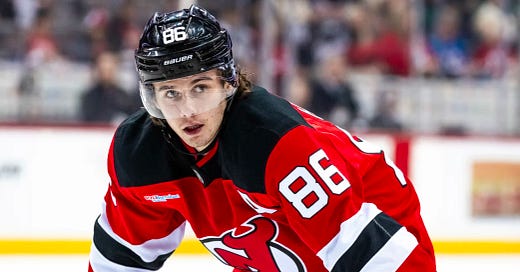Devils’ Best Had Better Be Better
As the clock ticked off the final seconds of the Devils’ 2-1 defeat to Ottawa, the kid-friendly Sunday afternoon crowd at Prudential Center grew quite ornery.
And for good reason, as this was the second consecutive winnable game for which the home team failed to bank any points, coming a day after sub-.500 Philadelphia escaped with a 3-1 victory at The Rock. It was the fourth straight loss and ninth in the last 11 games for the Devils (26-17-6), who have fallen into third place in the Metropolitan Division on points percentage after a torrid first half of the season.
On top of the boos raining down from the rafters, one particular fan on Sunday had seen enough of the deadwood in New Jersey’s bottom six. He screamed a plea to General Manager Tom Fitzgerald to acquire a third-line center, naming a host of potential trade options, from Vancouver’s All-Star J.T. Miller all the way down to former Ranger Barclay Goodrow, who is now laboring in obscurity in San Jose.
While such a move would undoubtedly help the Devils on paper, especially while center Erik Haula is on injured reserve with an ankle issue and career minor leaguer Justin Dowling wasting ice time in his place, Devils Head Coach Sheldon Keefe had a more realistic solution to his club’s woes. “Our best players have to be better,” Keefe said during Sunday’s postgame press conference.
We’re all looking at you, Jack Hughes.
The face of the Devils franchise has three goals and six assists over the last 11 games, which is far from brutal, but the story is the inconsistency. Hughes has gone pointless in six of the games, all defeats. For the season, here are his splits, per ESPN:
Wins: 14 goals, 25 assists, 39 points (1.5 per game), and plus-26 in 26 games
Losses: 4 goals, 12 assists, 16 points (0.7 per game), and minus-17 in 23 games
In other words, when Hughes (and linemate Jesper Bratt) are on their game, which includes finishing chances, the Devils usually win. If the opposition takes that line away with tight gap control and packing the net front, it spells trouble, like getting shut out six times already this season. The commitment to defending in Keefe’s system is keeping the team in games, but because the team’s success is so dependent on the production of its top two lines, New Jersey is 0-13-3 when they don’t reach three goals this season.
The frustration boiled over on Saturday when the Flyers blocked an unheard of 33 shots, which partially explains why the Devils registered a season-low 13 shots on goal. On the other side of Philadelphia’s rope-a-dope strategy, all three of their goals were initiated by soft Devils plays just inside their offensive zone. First, there was the Sean Couturier interception of a square Luke Hughes pass along the blue line that sent Matvei Michkov in on Devils goalie Jake Allen for a breakaway that tied the game at 1-1 early in the second period.
But the backbreaker came after the Devils had the Flyers pinned in their own end for a lengthy stretch in the middle of the third period, enough so Jack Hughes could come over the boards to change out for Nico Hischier. Hughes was given the puck at the top of the blue line, but it was poked away and Philadelphia’s Owen Tippett raced the other way. Devils defenseman Jonas Siegenthaler prevented a more dangerous Tippett attempt on Allen with a slash, but the Flyers cashed in on the ensuing power play. For good measure, Philadelphia’s Tyson Foerster outworked three Devils above the left circle to nudge what should have been a clean New Jersey faceoff win out to center ice for Travis Konecny to bury the empty netter with two seconds remaining.
The Hughes giveaway stung because it’s a play we have seen dozens of times. With his extraordinary skating and skill with the puck, he likes to use all 6,375 square feet of the offensive zone. That includes the 85 feet along the blue line, a high-risk endeavor. Cough up the puck there and no one can get back to clean up the mistake. I had thought Keefe had coached Hughes out of trying to make plays that had such a high-turnover expectation in such dangerous areas; evidently, he’s had a relapse.
But they’re certainly not paying Keefe the big bucks to deal with the friendly media; it’s to prod the team’s young stars into playing the right way without causing backlash. Hughes, New Jersey’s No. 1 overall pick in the 2019 NHL Draft, might only be 23, but this is sixth pro season. He ought to know right from wrong.
Hughes also happens to be the Devils’ power play engine, which has cooled off considerably from a roaring start. Many of the set-ups begin with him getting the puck along the left half-wall. His decision-making from there is key. Unfortunately, New Jersey has converted on just 4-of-26 (15.4%) man advantages over the last 11 games, the sixth-worst rate in the league.
The denominator is almost as alarming, as it’s an indicator that the Devils aren’t succeeding in getting into the hard areas where they can draw penalties. Obviously, that’s not entirely on Hughes, as the team needs all lines working to pressure the puck and create scoring opportunities either off the rush or through sustained offensive zone time. That’s how most penalties are drawn.
Such manners is also how both Devils goals were scored this weekend, but it was the team’s fourth line that generated them. After peppering the Ottawa net with 16 shots on goal in Sunday’s first period, they hit the net only 10 more times thereafter. Hughes had but one of them.
When that happens, the “L’s” are usually a foregone conclusion.



